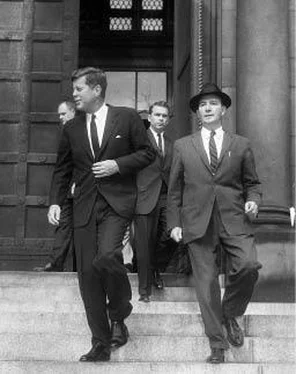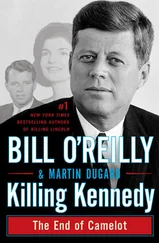O’Reilly, Bill - Killing Kennedy
Здесь есть возможность читать онлайн «O’Reilly, Bill - Killing Kennedy» весь текст электронной книги совершенно бесплатно (целиком полную версию без сокращений). В некоторых случаях можно слушать аудио, скачать через торрент в формате fb2 и присутствует краткое содержание. Год выпуска: 2012, Издательство: Henry Holt and Company, Жанр: Старинная литература, на английском языке. Описание произведения, (предисловие) а так же отзывы посетителей доступны на портале библиотеки ЛибКат.
- Название:Killing Kennedy
- Автор:
- Издательство:Henry Holt and Company
- Жанр:
- Год:2012
- ISBN:нет данных
- Рейтинг книги:5 / 5. Голосов: 1
-
Избранное:Добавить в избранное
- Отзывы:
-
Ваша оценка:
- 100
- 1
- 2
- 3
- 4
- 5
Killing Kennedy: краткое содержание, описание и аннотация
Предлагаем к чтению аннотацию, описание, краткое содержание или предисловие (зависит от того, что написал сам автор книги «Killing Kennedy»). Если вы не нашли необходимую информацию о книге — напишите в комментариях, мы постараемся отыскать её.
Killing Kennedy — читать онлайн бесплатно полную книгу (весь текст) целиком
Ниже представлен текст книги, разбитый по страницам. Система сохранения места последней прочитанной страницы, позволяет с удобством читать онлайн бесплатно книгу «Killing Kennedy», без необходимости каждый раз заново искать на чём Вы остановились. Поставьте закладку, и сможете в любой момент перейти на страницу, на которой закончили чтение.
Интервал:
Закладка:
In the bow of PT-109, Ensign George “Barney” Ross of Highland Park, Illinois, also peers into the night. His previous boat was recently, accidentally, sunk by an American bomber, and he volunteered for this mission as an observer. Now Ross is stunned when, through his binoculars, he sees the Amagiri just 250 yards away, bearing down on 109 at full speed. He points into the darkness. The skipper sees the ship and spins the wheel hard, trying to turn his boat toward the rampaging destroyer to fire his torpedoes from point-blank range—either that, or the Americans will be destroyed.
PT-109 can’t turn fast enough.
It takes just a single terrifying instant for Amagiri to slice through the mahogany hull. The diagonal incision begins on the right side, barely missing the cockpit. The skipper is almost crushed, at that moment thinking to himself, “This is how it feels to be killed.” Two members of the thirteen-man crew die instantly. Two more are injured as PT-109 explodes and burns. The two nearby American boats, PT-162 and PT-169, know a fatal blast when they see one, and don’t wait around to search for survivors. They gun their engines and race into the night, fearful that other Japanese warships are in the vicinity. Amagiri doesn’t stop either, speeding on to Rabaul, even as her crew watches the small American craft burn in her wake.

Lieutenant John Fitzgerald Kennedy in the cockpit of PT-109. (Photographer unknown, Papers of John F. Kennedy, Presidential Papers, President’s Office Files, John F. Kennedy Presidential Library and Museum, Boston)
The men of PT-109 are on their own.
The skipper, and the man responsible for allowing such an enormous vessel to sneak up on his boat, is Lieutenant John Fitzgerald Kennedy. He is twenty-six, rail thin, and deeply tanned, a Harvard-educated playboy whose father forced him to leave naval intelligence to seek a combat position when it was discovered that his son’s Danish mistress was suspected of being a Nazi spy. Being second-born in a family where great things are expected from the oldest son, Kennedy has had the luxury of a frivolous life. He was a sickly child, grew into a young man fond of books and girls, and, with the exception of commanding a minor vessel such as PT-109, has shown no interest in pursuing a leadership position in politics—an ambition required of his older brother, Joe.
But none of that matters right now. Kennedy must find a way to get his men to safety. Later in life, when asked to describe the night’s imminent turning point, he will shrug it off: “It was involuntary. They sunk my boat.”
His words belie the fact that he might have been court-martialed for allowing his boat to be sunk and two of his men to be killed. But the sinking of PT-109 will be the making of John F. Kennedy—not because of what just happened, but because of what is about to happen next.
The back end of PT-109 is already on its way to the bottom of the Blackett, some 1,200 feet below. The forward section of the hull remains afloat, thanks to watertight compartments. Kennedy gathers the surviving crew members on this section to await help. Amagiri ’s wake is sweeping the flames away from the wreckage of 109, allaying Kennedy’s fears that the gasoline fires will ignite any remaining ammunition or fuel tanks. But as the hours pass—one, then two and three—and it becomes obvious that help is not coming, Kennedy knows he must devise a new plan. The Blackett Strait is bordered on all sides by small islands that are home to thousands of Japanese soldiers. It’s certain that someone on land has seen the explosion.
“What do you want to do if the Japs come out?” Kennedy asks the crew. Completely responsible for the lives of his men, he is at a loss. The hull is beginning to sink, and the only weapons he and his men possess are a single machine gun and seven handguns. A firefight would be ludicrous.
The men can plainly see a Japanese camp less than a mile away, on Gizo Island, and know that two other large bases exist on Kolombangara and Vella Lavella islands, each just five miles away.
“Anything you say, Mr. Kennedy. You’re the boss,” replies one crewman.
But Kennedy is not comfortable being the boss. In his months being skipper of the 109, his job has largely consisted of steering the boat. The men complain that he is more interested in chasing girls than commanding a ship. Kennedy is much more at ease in a supporting role. Growing up, he took orders from his domineering father and looked up to his charismatic older brother. His dad, Joseph P. Kennedy, is one of the wealthiest and most powerful men in America, and a former ambassador to Great Britain. His brother Joe, at twenty-eight years old, is a flamboyant naval aviator soon to see action flying antisubmarine missions against the Nazis in Europe.
The Kennedy family takes all its directives from their patriarch. John Kennedy will one day liken the relationship to that of puppets and their puppet master. Joseph P. Kennedy decides how his children will spend their lives, monitors their every action, attempts to sleep with his sons’ and daughters’ girlfriends, and even had one of his own daughters lobotomized. He has already pinpointed Joe as the family politician. Indeed, his father saw to it that his eldest was a delegate at the 1940 Democratic National Convention. Meanwhile, in those days before the war broke out, John spent his time writing and traveling. Many in the family still believe that writing might become his chosen profession.
Now, on this tragic Pacific night, there is no way for Joseph P. Kennedy to tell his son what to do. “There’s nothing in the book about a situation like this,” JFK tells the crew, stalling for time. “Seems we’re not a military organization anymore. Let’s just talk this over.”
The men have been trained to follow orders, not discuss strategy. They argue, and yet Kennedy still won’t play the role of commander. The men have been waiting for a ship to come looking for them, or a search plane. As morning turns to noon, and PT-109 sinks lower and lower into the water, remaining with the wreckage means either certain capture by Japanese troops or death by shark attack.

The Kennedy family at their Hyannis Port compound in 1931. (Photograph by Richard Sears, John F. Kennedy Presidential Library and Museum, Boston)
Finally, John F. Kennedy takes charge.
“We’ll swim,” he orders the men, pointing to a cluster of green islands three miles to the southeast. He explains that while these specks of land might be more distant than the island of Gizo, which appears close enough almost to touch, they’re less likely to be inhabited by Japanese soldiers.
The men hang on to a piece of timber, using it as a flotation device as they kick their way to the distant islands. Kennedy, a member of the swim team at Harvard, tows a badly burned crew member by placing a strap from the man’s life jacket between his own teeth and pulling him. During the five long hours it takes to reach the island, Kennedy swallows mouthful after mouthful of saltwater, yet his strength as a swimmer allows him to reach the beach before the rest of the crew. He leaves the burned crewman in the shallows and staggers ashore to explore their new home. The island is not much: sand, a few palm trees, and the reef that surrounds it. From one side to another, it’s just a hundred yards. But it’s land. After more than fifteen hours in the ocean, there’s no better place to be.
Читать дальшеИнтервал:
Закладка:
Похожие книги на «Killing Kennedy»
Представляем Вашему вниманию похожие книги на «Killing Kennedy» списком для выбора. Мы отобрали схожую по названию и смыслу литературу в надежде предоставить читателям больше вариантов отыскать новые, интересные, ещё непрочитанные произведения.
Обсуждение, отзывы о книге «Killing Kennedy» и просто собственные мнения читателей. Оставьте ваши комментарии, напишите, что Вы думаете о произведении, его смысле или главных героях. Укажите что конкретно понравилось, а что нет, и почему Вы так считаете.











